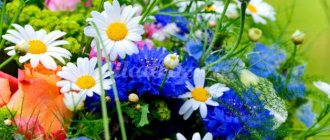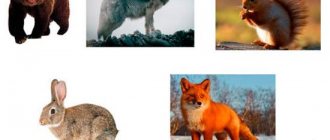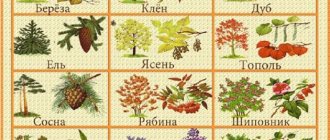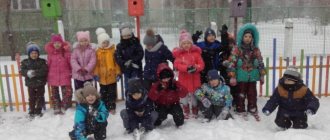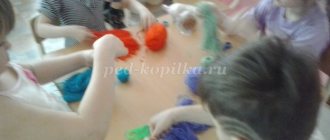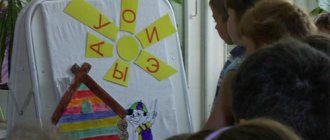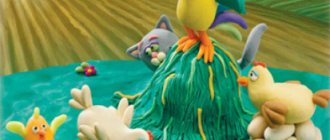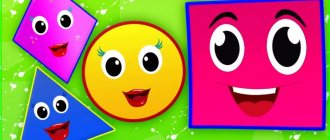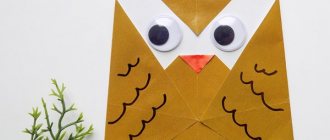Summary of a conversation with children of the preparatory group on the topic: “Coniferous trees”
Municipal autonomous preschool educational institution
"Child Development Center-Kindergarten No. 2"
Sleep conversation topic:
"Coniferous trees"
Preparatory group
Educator: Medvedeva A. A.
Saransk 2022
Target:
Expand your understanding of coniferous trees growing in your native land
Tasks:
Develop cognitive activity, thinking, and communication skills of children. Develop the ability to compare and draw conclusions based on your own observations. Cultivate a caring attitude towards trees.
Materials and equipment:
images of coniferous trees, forest inhabitants, sun, water, snow, wind, wooden ship (boat), wooden products, products made from the fruits of coniferous trees;
conifer cones. Progress of the conversation:
Educator. Today I invite you to talk about interesting, useful and very beautiful trees. Guess the riddle about them: “Winter and summer in the same color.” Why do they say this? What do you know about these trees? Children's answers. Educator There are no leaves on it, there are needles. Both in winter and in the summer heat, Cheerful and green, Full of long cones! Spruce trees are slender trees with fluffy branches covered with pine needles. Spruce is not only a beautiful tree, but also a very necessary and important tree for animals and birds. Let's look at the pictures and say who needs a spruce and why. (Lays out the images in front of the children.) The bear makes a den under the spruce tree and sleeps in it until spring. A hare hides behind a spruce tree from a fox and a wolf. An owl, sitting on a spruce tree at night, looks out for prey. A squirrel collects fir cones. You can often see mice under spruce trees because they collect grains that have fallen from the cones. And in winter, the spruce feeds crossbill beetles with its cones. That's how important spruce is for animals! And coniferous trees are important for humans. It is very easy to breathe in a coniferous forest. Spruce is used to make paper, film, cardboard and many other useful things. And now I offer you a riddle. What a tree! Needles Longer than those of a Christmas tree! But it looks like a Christmas tree - it’s green all the time too. Round cones stick out - What fun for the guys! What tree is this riddle about? That's right, about pine. Pine, unlike spruce, is a light-loving plant. It is very light in the pine forest. Pine branches grow only on the top of the head. The cones also differ. Let's compare. Children compare spruce and pine cones. Educator: A forest with a lot of pine trees is called a pine forest. What does a plant need to grow? (Shows images.) The sun gives plants light and warmth. They also need the moisture that water provides. Snow covers plants in frosty weather. The wind carries pollen from one tree to another. Pine is friends with plants that love light - blueberries, lingonberries. Crossbills like to peel cones on pine trees, and wood grouse in winter feed on pine needles. Squirrels prefer to make a hollow in a pine tree, and woodpeckers destroy bark beetles that are harmful to the tree. He loves pine and elk; he feeds on pine needles and the bark of young trees during the difficult winter season. Ants build their houses - anthills - from pine needles. Pine air is very useful for people, especially for breathing. That is why many sanatoriums and hospitals are built in pine forests. Pine is a ship's wood: since ancient times, boats and ships have been built from pine logs, because pine wood is a light but very strong material. (Shows an image.) And now pine is used in the construction of some parts of modern ships. They also build houses and make furniture from pine. Another very interesting coniferous tree is cedar pine, or cedar. This tree is very common in Siberia; it also grows in Udmurtia. I want to tell you a legend about the origin of this amazing tree. In ancient times, a tribe of hunters lived in the Sayan mountains. Taiga regularly fed and watered them. This continued until disaster came to these parts: one day, during a thunderstorm, a strong fire started, the taiga burned out for many miles around. Animals and birds left these lands. One spring night, when the stars shine brighter than usual, one of them fell from the sky and fell into the very heart of the taiga. This was noticed by one of the oldest hunters. In the morning, when the sun rose, he found this place and saw how a green sprout appeared in place of the burning place. The elder collected spring water and watered the plant. Arriving at this place after some time, he saw, instead of a weak sprout, a young tree covered with cones. Having collected a harvest of delicious nuts, the elder treated them to his villagers. And the tree grew and grew, gaining strength. People noticed that with his appearance their lives became brighter. They began to get sick less, hard times, hunger and pestilence began to pass them by. Every year they learned more and more about the power of the tree and its healing properties. The tree was nicknamed “generous” for its generosity. And we call it cedar. Cedar is a very necessary and very beautiful tree. Cedar fruits are hidden in small cones. And these fruits are distributed by animals and birds. Look at the picture {shows) and say what is shown here. Children's answers. Educator: Why are all these items collected together? All these things and objects are made from wood, walnut, and cedar needles. Musical instruments are made from cedar wood, they decorate the facades of houses; in the old days, our grandfathers made chests in which moths never appeared, dishes in which milk never spoiled. Oil is made from pine nuts, and medicine is made from cedar needles. This is how much benefit cedar brings to all people! There is also an interesting tree in our forests - fir. It has long needles and a fragrant smell. But the fir needles do not prick at all. Fir needles are very soft. Many people make brooms from fir branches and use them to steam themselves in the sauna. Let's look at the fir cone. Let's compare it with other cones. Fir, like other trees, brings great benefits to people and animals. Which one do you think? Children look at the pictures and talk about fir. Educator: And now I invite you to get acquainted with another coniferous tree - larch. Larch is an amazing tree: it is very similar to the other 22 coniferous trees, but in the fall the needles of the larch fall off, and new ones grow in the spring. Larch wood is very durable and is used in construction. Now choose any picture and tell us what you remember about this tree. Children talk.
